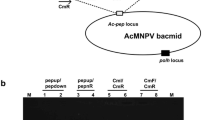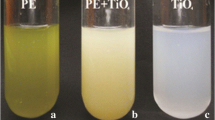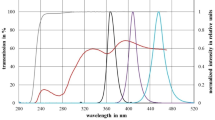Abstract
Titanium dioxide (TiO2)reflects ultraviolet light, and so could beexpected to protect the occlusion bodies (OBs)of nucleopolyhedroviruses (NPVs) fromdegradation by sunlight. However, in thepresence of sunlight and water, TiO2catalyzes the formation of hydrogen peroxide,which can degrade OBs. We tested microfineTiO2 that had been photostabilized(particles were coated to prevent catalyticactivity), as a UV protectant for the OBs ofthe NPV of Helicoverpa zea (Boddie). Inthe absence of UV, activity of the OBs wasreduced by nonphotostabilized TiO2 but wasunaffected by photostabilized TiO2 or byzinc oxide (ZnO). None of these materialsinfluenced larval feeding rates. Undersimulated sunlight, photostabilizedTiO2 protected the OBs to a greater degreethan did ZnO. Photostabilized TiO2 wascompatible with a viral enhancer, thefluorescent brightener Blankophor HRS. Undersimulated sunlight, both materials increasedactivity of the OBs, relative to OBs withneither material, in a largely additive manner. In bioassays of foliage collected from fieldplots of lima bean plants sprayed with OBs withor without one or both of these materials,TiO2 increased persistence of the OBs, butBlankophor HRS had no significant effect.
Similar content being viewed by others
References
Abbott, W.S., 1925. A method of computing the effectiveness of an insecticide. J. Econ. Entomol. 18: 265–267.
Adams, J.R. and J.T. McClintock, 1991. Baculoviridae. Nuclear polyhedrosis viruses. Part 1. Nuclear polyhedrosis viruses of insects. In: J.R. Adams and J.R. Bonami (eds), Atlas of invertebrate viruses. CRC Press, Boca Raton, FL. pp. 87–204.
Anderson, M.W., J.P. Hewwitt and S.R. Spruce, 1997. Broad-spectrum physical sunscreens: titanium dioxide and zinc oxide. In: N.J. Lowe, N.A. Shaath and M.A. Pathak (eds), Sunscreens: development, evaluation, and regulatory aspects (2nd edn., revised and expanded). Cosmetic Science and Technology Series 15. Marcel Dekker, New York. pp. 353–397.
Bull, D.L., R.L. Ridgway, V.S. House and N.W. Pryor, 1976. Improved formulations of the Heliothis nuclear polyhedrosis virus. J. Econ. Entomol. 69: 731–736.
Burges, H.D. and K.A. Jones, 1998. Formulation of bacteria, viruses, and Protozoa to control insects. In: H.D. Burges (ed), Formulation of microbial biopesticides. Kluwer, Dordrecht. pp. 33–127.
Fairhurst, D. and M.A. Mitchnick, 1997. Particulate sun blocks: general principles. In: N.J. Lowe, N.A. Shaath and M.A. Pathak (eds), Sunscreens: development, evaluation, and regulatory aspects (2nd edn., revised and expanded). Cosmetic Science and Technology Series 15. Marcel Dekker, New York. pp. 313–352.
Entwistle, P.F. and H.F. Evans, 1985. Viral control. In: G.A. Kerkut and L.I. Gilbert (eds), Comprehensive insect physiology, biochemistry, and pharmacology, vol. 12. Pergamon Press, Oxford. pp. 347–412.
Farrar, R.R., Jr. and R.L. Ridgway, 1997. The celery looper (Lepidoptera: Noctuidae) baculovirus: potency and enhancement by Blankophor BBH against 3 lepidopteran species. Environ. Entomol. 26: 1461–1469.
Farrar, R.R., Jr. and R.L. Ridgway, 1999. Relative potency of selected nuclear polyhedrosis viruses against five species of Lepidoptera. J. Agric. Urban Entomol. 16: 187–196.
Farrar, R.R., Jr., J.D. Barbour and G.G. Kennedy, 1989. Quantifying food consumption and growth in insects. Ann. Entomol. Soc. Am. 82: 593–598.
Granados, R.R. and B.A. Federici (eds), 1986. The biology of baculoviruses, vol. 2. Practical applications for insect control. CRC Press, Boca Raton, FL.
Hamm, J.J., 1999. Interactions in entomology: enhanced infectivity of entomopathogenic viruses. J. Entomol. Sci. 34: 8–16.
Hamm, J.J., L.D. Chandler and H.R. Sumner, 1994. Field tests with a fluorescent brightener to enhance infectivity of fall armyworm (Lepidoptera: Noctuidae) nuclear polyhedrosis virus. Fla. Entomol. 77: 425–437.
Hoffman, M.R., S.T. Martin, W. Choi and D.W. Bahnemann, 1995. Environmental applications of semiconductor photocatalysis. Chem. Rev. 95: 69–96.
Hunter-Fujita, F.R., P.F. Entwistle, H.F. Evans and N.E. Cook, 1998. Insect viruses and pest management. Wiley, Chichester. xii + 620 pp.
Ignoffo, C.M. and O.F. Batzer, 1971. Microencapsulation and ultraviolet protectants to increase sunlight stability of an insect virus. J. Econ. Entomol. 64: 850–853.
Ignoffo, C.M. and C. Garcia, 1994. Antioxidant and enzyme effects on the inactivation of inclusion bodies of the Heliothis baculovirus by simulated sunlight-UV. Environ. Entomol. 23: 1025–1029.
Ignoffo, C.M., D.L. Hostetter, P.P. Sikorowski, G. Sutter and W.M. Brooks, 1977. Inactivation of representative species of entomopathogenic viruses, a bacterium, fungus, and protozoan by an ultraviolet light source. Environ Entomol. 6: 411–415.
Jaques, R.P., 1977. Stability of entomopathogenic viruses. In: C.M. Ignoffo and D.L. Hostetter (eds), Environmental stability of microbial insecticides. Misc. Publ. Entomol. Soc. Am. 10. pp. 99–116.
Jaques, R.P., 1985. Stability of insect viruses in the environment. In: K. Maramorosch and K.E. Sherman (eds), Viral insecticides for biological control. Academic Press, Orlando, FL. pp. 285–360.
King, E.G. and G.G. Hartley, 1985. Heliothis virescens. In: P. Singh and R.F. Moore (eds), Handbook of insect rearing, vol. II. Elsevier, NY. pp. 323–328.
Maramorosch, K and K.E. Sherman (eds), 1985. Viral insecticides for biological control. Academic Press, Orlando, FL.
McGuire, M.R., R.W. Behle, H.N. Goebel and T.C. Fry, 2000. Calibration of a sunlight simulator for determining solar stability of Bacillus thuringiensis and Anagrapha falcifera nuclear polyhedrovirus. Environ. Entomol. 29: 1070–1074.
The National Library of Medicine, 1999. Hazardous substances data bank. The National Library of Medicine, Bethesda, MD. Silver Platter International, N.V.: Search and Retrieval Software.
SAS Institute, 1988. SAS/STAT user's guide, release 6.03 edition, Cary, North Carolina.
Shapiro, M., 1992. Use of optical enhancers as radiation protectants for gypsy moth (Lepidoptera: Lymantriidae) nuclear polyhedrosis virus. J. Econ. Entomol. 85: 1682–1686.
Shapiro, M. 1995. Radiation protection and activity enhancement of viruses. In: F.R. Hall and J.W. Bany (eds), Biorational pest control agents: formulation and delivery. Am. Chem. Soc. Symp. Ser. 595, Am. chem. Soc., Washington, DC. pp. 153–164.
Shapiro, M. and J.L. Robertson, 1992. Enhancement of gypsy moth (Lepidoptera: Lymantriidae) baculovirus activity by optical enhancers. J. Econ. Entomol. 85: 1120–1124.
Shapiro, M., J.J. Hamm and E. Dougherty, 1992. Compositions and methods for biocontrol using fluorescent enhancers. U.S. Patent 5,124,149.
Vail, P.V., T.J. Henneberry, D.F. Hoffman, M.R. Bell, L.J.F. Jech and J.S. Tebbets, 1993. The influence of a bait and fluorescent brightener on activity of the celery looper nuclear polyhedrosis virus for lepidopterous cotton pests. In: Proc. 1993 Beltwide Cotton Conf. pp. 1014–1016.
Vail, P.V., D.F. Hoffman and J.S. Tebbets, 1999. Influence of fluorescent brighteners on the field activity of the celery looper nucleopolyhedrovirus. Southwest. Entomol. 24: 87–98.
Author information
Authors and Affiliations
Corresponding author
Rights and permissions
About this article
Cite this article
Farrar, R.R., Shapiro, M. & Javaid, I. Photostabilized titanium dioxide and a fluorescent brightener as adjuvants for a nucleopolyhedrovirus. BioControl 48, 543–560 (2003). https://doi.org/10.1023/A:1025723316426
Issue Date:
DOI: https://doi.org/10.1023/A:1025723316426




